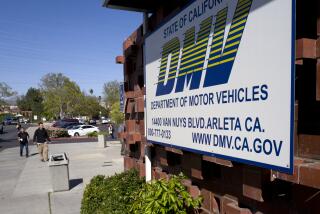New GED Is Putting Takers to the Test
Oxnard resident Daniel Govea, 25, knows the GED test he plans to take later this month is much more difficult than the one offered last year.
But Govea, who dropped out of high school seven years ago, is determined to get his certificate even if it means more studying.
“It would have been easier to pass before, but I’m pretty confident that I’ll still be able to pass it,” he said. “What I really wish is that I would have just graduated from high school.”
For the first time since 1988, the General Education Development exam has been revised to keep up with evolving high school graduation requirements. The GED is taken by more than 50,000 Californians annually seeking a second chance at earning a high school diploma.
The revamped exam is bringing anxiety over its increased difficulty, new testing procedures and scoring delays, officials said.
The test “certainly is different, but it’s also harder by design,” said Lyn Schaefer, director of development for the GED Testing Service at American Council on Education. “The knowledge that just about every state was evaluating their graduation standards prompted us to look at the [old] test and ask, ‘How well does this match up with what high school students are going to be doing in the 21st century?’”
The change causing the most apprehension is the move to a two-part math test that places a greater emphasis on algebra. On the first half, students may use a calculator, which was not permitted before, and some math questions now require students to work through problems rather than choosing a multiple-choice answer.
There are also more test questions that assess both practical knowledge and analytical ability. On the nonfiction section of the reading test, for example, students are more likely to find a job training manual than a theater review, while items like recipes and nutritional content labels are part of word problems on the math segment. And the written essay portion has taken on more significance in overall scoring.
Although the new test was instituted Jan. 14, most adult schools and test centers throughout Ventura County and Southern California have only recently started administering it.
The Los Angeles Unified School District, for instance, which operates the state’s largest GED testing center, offered it for the first time two weeks ago. Simi Valley Adult School has scheduled its first testing session later this month.
Nancy Edmunds, associate analyst for the California GED Office, said difficulty in obtaining student workbooks, practice tests and other preparation materials forced delays at many schools.
Many people opted to take the old GED exam before it was retired on Dec. 31. Edmunds estimates that nearly 70,000 people took the GED in California last year, a 20% jump over the number of test-takers in 2000.
The GED Testing Service warned test-takers who may have passed one or more sections of the old test that they would not be permitted to roll over their scores once the new exam was introduced. Coupled with publicity over the new test’s increased rigor, virtually every test site in the region saw a flurry of last-minute test-takers.
“We sent out letters starting in June to anybody who has taken the GED with us during the last 10 years, and in September we had this huge rush,” said Linda Sugino, GED testing examiner at Oxnard Adult School. “I was testing almost every day through November and December, and we had full houses every night.”
Some test sites have started spreading the 7 1/2-hour test over two or more days as part of the changeover. Bill Macri, chief GED examiner at Simi Valley Adult School, said a new eight-page, pretest demographic survey made it less feasible to allow test-takers to complete the entire exam in one sitting.
But officials say the switch to the new test has gone smoothly. Sugino recently received her first round of scores and says she was pleasantly surprised by the results.
“I was a bit leery because of the new testing form, but they did well, better than I was expecting,” she said.
Edmunds, of the California GED Office, says it is too early to say what effect the more difficult exam is having on passing rates. Preliminary results show that test-takers are struggling the most with the math and writing portions, just as they did with the old test, she said.
So far, the main problem the new test has created is a scoring backlog that has increased the amount of time test-takers have to wait for their results--and, if they passed, their diplomas--from about two weeks to a month or longer.
Edmunds said state officials are working to speed up the processing of scores and in certain emergency situations, have been able to give candidates whose futures rest on whether they passed at least verbal confirmation on their standing.
“In some cases, it can mean the difference between financial aid or not, and it can mean the difference between getting a job or not,” Edmunds said. “For the person taking the exam, it means whether they can get on with their life.”
More to Read
Sign up for Essential California
The most important California stories and recommendations in your inbox every morning.
You may occasionally receive promotional content from the Los Angeles Times.










